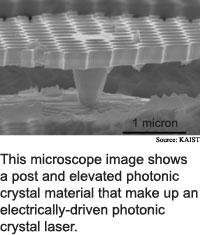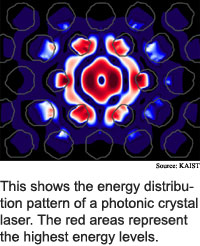
Photonic crystal lasers juiced
Photonic crystal materials contain tiny,
regularly spaced air holes or semiconductor rods that make it possible
to channel light within microscopic spaces. The material promises to enable
all-optical computer circuits and could also be used to make ultra low-power
light sources, including lasers.
Researchers have made lasers from microscopic cavities in photonic
crystals that act as reflectors to intensify the collisions between photons
and atoms that lead to lazing, but these lasers have been optically-pumped,
meaning they are driven by other lasers.
Researchers from the Korean Advanced Institute of Science and
Technology and the Electronics and Telecommunications Research Institute
in Korea have made a photonic crystal laser that is driven by electric
current. The device could eventually be used as a source of single photons
for quantum cryptography and communications devices, as an ultra low-power
laser, and as a light source for photonic crystal circuits.
The room-temperature device produced light at the telecommunications
wavelength of 1.5 microns using 260 millionths of an amp of electrical
current. Laser pointers typically use several hundred thousandths of an
amp.
The laser consists of a 50-micron-wide photonic crystal suspended
above a surface. A one-micron-high semiconductor post connects the surface
to the center of the crystal. A micron is one thousandth of a millimeter.
The post serves as an electrode that carries electrical current into the
device.
The challenge in making an electrically-driven photonic crystal
laser was configuring the post to conduct current efficiently while minimizing
the post's impact on the cavity's optical properties, according to the
researchers.
The work appeared in the September 2, 2004 issue of Science.
Ultrathin carbon speeds circuits
DNA machines take a walk
DNA in nanotubes sorts molecules
Single field shapes quantum bits
Briefs:
Nanotubes lengthen to centimeters
Coated nanotubes record light
Photonic crystal lasers juiced
Lasers move droplets
Molecules form nano containers
Square rings promise reliable MRAM


Research Watch blog
View from the High Ground Q&A
How It Works
RSS Feeds:
News
Ad links:
Buy an ad link
Ad links: Clear History
Buy an ad link
|
TRN
Newswire and Headline Feeds for Web sites
|
© Copyright Technology Research News, LLC 2000-2010. All rights reserved.